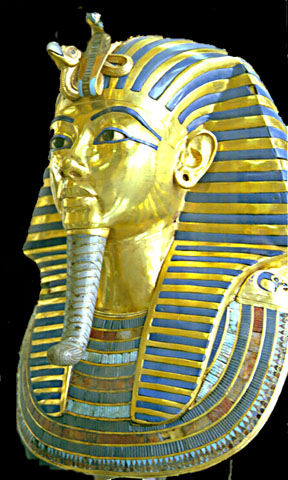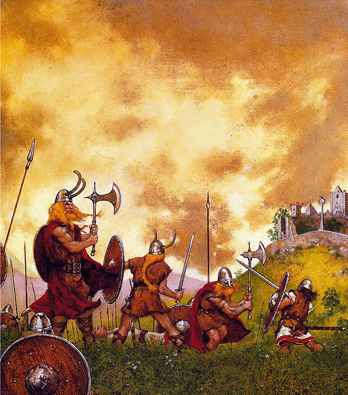|
People fought for their benefits, for glory, for victory, even for peace. But not every war ended with peace, most war
brought suffering.
After the Ice Age, humans established the first civilization.

|
| Pharoah |
Egypt was established during the Stone Age, while the Chinese had done this 1000 years before, they were scattered. The lower
part of Egypt fought with the upper part of Egypt, it ended when Menes, the pharaoh of the upper part conquered the lower
part. He then united Egypt and combined the crowns of Pharaohs into one. There were a few gods during the reign of Khufu,
the owner of the largest Pyramid in the world. The Egyptians invented paper made from trees, it was useful in their artwork.
As the Egyptians began to capture more land from other tribes, their territory grew. Then the Persians invaded Egypt (525-404B.C.)
and this was during the late period of Egypt. Then Alexander the Great overran Egypt, the Egyptians surrendered before Alexander
launched his first attack, and named Alexander ‘The Son of Ra’. Egyptian culture and myths fell after this, they
left only the Pyramids and Mummies for us to study.

|
| The Great Wall of China |
In Asia, the earliest civilization was established on the upper part of Huang He (a river with yellowish water), the ancient
Chinese used club with a roughly-made stone knife as weapon. As they lived near the river, they gained food easily, so they
had time to think: Who brought us to this world? Then they imagined all kinds of legendary tales as their answers. After Qin
Shi Huang united China, the prophet of China started Dao; they studied myths and taught people the morals. Chinese symbolize
the dragon as the emperor; they believed that the dragon was the greatest animal. And they also symbolize the Phoenix as the
queen. The dynasty of Han was the strongest period of China, there were many inventions like paper, bombs, compasses and china.
Then the temporary decline of China was during the reign of the Mongols. But the Chinese drove them off and established the
Ming dynasty. Then the Manchu ruled China in 1644, but the people were still studying mythology. The studies died when the
Europeans invaded China.

|
| India |
In about 321 (easy to memorize) B.C., the foundation of India was done. Buddhism started, Ashoka converted to it. Ashoka
was the emperor of India (269-230B.C.), he listen to his people’s advice and views. Buddha was born in 563B.C; he was
believed to have saved suffering people. This religion, a part of mythology, spread into the land of East Asia. The people
of the East Asia believed in this stuff, until now.
These 3 countries have a similar, internal disorder. It was a
matter of the ruler; nearly every civil war happened because of the mistake of an emperor. When the people lost their confidence
in the king, they rioted. This is why the empire of Egypt fell.
On the other hand, the Chinese civilization was the
longest-lasting kingdom until now. The Indians were nearly 4500 years after the Chinese. Until now, many Chinese still have
a superstitious belief in myths; this affected the advance of China.
Beyond the Myths—Greek, Roman, and Norse—Part Two

|
| Spratans are great warriors |
This is about wars, the aggressive nations that show no mercy upon the weak.
There is no doubt that the Greeks
were great fighters. Spartans trained themselves since they were only kids, while Athenians studied philosophy and the art
of mythology. In 776B.C, the first Olympic game began. The Greeks believed that the gods lived at Mount Olympus, where the
Olympic games were held. Zeus, the lightning god, was said to be the head of the gods. During the Dark Age, the Greeks started
to fall, followed by the victory against Persians. But Sparta and Athens fought against each other, ending with the victory
of Sparta. But Thebes defeated Sparta in the end. In the end, Greece lost in the war against the Macedonians. Then the Macedonians
became a part of Rome, and this is why the Greek culture is a bit similar to the Romans'. Even the gods of the Romans are
same as the Greek, but their names were different.

|
| Norse, the fighter's land |
Next up is the Norse peoples of Northern Europe, they are Norway, Sweden, and Denmark. These countries are believed as
the homeland of the Vikings. In 787, the Vikings launched their first raid on England beaches. Then in 795 and 834, Ireland
and Netherlands were invaded by them. But the Vikings were defeated by the English, and there was peace, for a while. Until
1030, the Vikings still had their own religion and trust in mythology. But after this, the Holy Roman Empire captured their
lands, and they were converted to Christianity. The Vikings finally gave up their gods, and the Holy Empire destroyed their
things and the historical remains. This caused the loss of Norse mythology studies, only other culture-related counties maintained
the lead of Norse myths, like Germany.
While the Vikings fell, there was a civilization building up in Ancient America.
|
